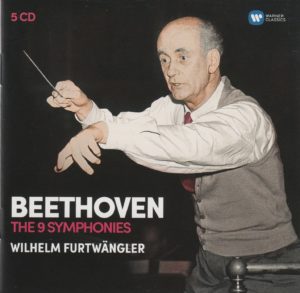 This morning I am listening to Wilhelm Furtwangler (1886-1954), the Wiener Philharmoniker, and Beethoven’s Symphony No. 4 in B flat Major.
This morning I am listening to Wilhelm Furtwangler (1886-1954), the Wiener Philharmoniker, and Beethoven’s Symphony No. 4 in B flat Major.
Even if his conducting wasn’t legendary, I’d likely be a fan of Maestro Furtwangler just because it’s fun to say his name: “Furtwangler.”
See?
I’m smiling right now as I say it.
I have encountered Maestro Furtwangler (smile) three times previously in my Beethoven project, on…
Day 7. Rating: Not “Meh!”, not “Huzzah!”
Day 25. Rating: “Meh!” (in fact, a “big, fat ‘Meh!’, according to what I wrote)
Day 43. Rating: “Huzzah!”
So far, Furtwangler (smile) is only 1 out of 3 with my ratings: one “Huzzah!” out of three performances. One came really close (Day 7). But, as they say, close only counts in horseshoes and hand grenades.
Let’s see what today brings.
 Beethoven wrote his symphonies in four parts (except for the Sixth, which is in five). The time breakdown of this particular one (Symphony No. 4 in B flat Major), from this particular conductor (Furtwangler, at age 62) and this particular orchestra (Wiener Philharmoniker), at this particular time in history (Recorded October 3, 1948) on this particular record label (Warner Classics) is as follows:
Beethoven wrote his symphonies in four parts (except for the Sixth, which is in five). The time breakdown of this particular one (Symphony No. 4 in B flat Major), from this particular conductor (Furtwangler, at age 62) and this particular orchestra (Wiener Philharmoniker), at this particular time in history (Recorded October 3, 1948) on this particular record label (Warner Classics) is as follows:
I. Adagio – Allegro vivace……………………………………………………………….10:41
II. Adagio………………………………………………………………………………………..11:49
III. Allegro molto e vivace – Trio. Un poco meno allegro………………..6:01
IV. Allegro ma non troppo………………………………………………………………..7:36
Total running time: 35:27
My Rating:
Recording quality: 4 (noticeable tape hiss, and a discernibly mono recording…sounds flat and old)
Overall musicianship: 3 (seems subdued, lacking dynamics)
CD liner notes: 4 (essays on Furtwangler written in English, German, and French, however historical details missing or hard to find: Where was this recorded? When? What orchestra? That information is in small print on the back of the CD sleeves)
How does this make me feel: 3 (bored)
When I compared this to other recordings (especially Konwitschny and Bernstein) I realize that even though this doesn’t sound bad, it’s not stellar. It’s very nice, even more so because of its historical importance (it was recorded in 1948, by a legendary conductor, and an equally legendary orchestra). But it’s not as remarkable as other performances from other conductors.
Plus, at 35:27, it seems to drag on and on – and not in a roller-coaster, breathless way. Rather, in a funeral procession way. Even the parts that are supposed to be brisk and exciting don’t rouse me from my slumber.
Furtwangler (smile) has sounded better to my ears. This performances wasn’t one of his better ones.
“Meh!”
